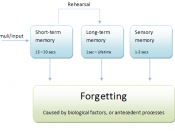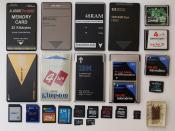THE HUMAN MEMORY
Memory is an information processing system. Webster's dictionary explains, "Memory as the faculty by which sense impressions and information are retained consciously or unconsciously in the mind and subsequently recalled." A great professor by the name of Michael Gibbons stated that, "Memory is any indication that learning has persisted over time." There are generally three types of memory: sensory memory, short-term memory and long-term memory.
Sensory memory is the first level of memory. Sensory memory retains the brief impression of a sensory stimulus after the stimulus itself has ended. An example of sensory memory is when you see an object, then the object disappears but it still may be vivid in your memory. The sensory memory holds a short impression of sensory information even when the sensory system does not send any information anymore. Most research has focused on the visual and auditory systems, although there are most likely sensory registers for all our sense.
A sensory memory exists for each sensory channel: iconic for visual, echoic for hearing stimuli and hapitc for touch. It's hard to determine how much information sensory memory can hold, because the information is always fading as scientists try to measure it.
George Sperling first studied iconic memory. He showed subjects sets of letters and asked them to name as many letters as they could remember. Sperling flashed the cards quickly and asked the subjects to remember the letter on the card. The subjects later could recall 3-4 cards, but not all. George Sperling
determined that the memory was lost over the short period of time that lapsed. He also came to the conclusion that the information that we pay attention to is the ones that move on to further processing. Information that we don't pay attention to is not likely to...



Very detailed
I was going to write something... but forgot! No only kidding! Good research has obviously gone into this essay. A subject you dont see much.
Well done!
5 out of 5 people found this comment useful.